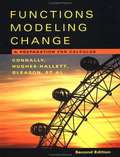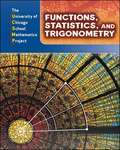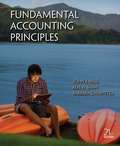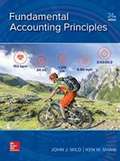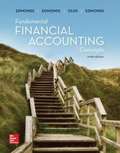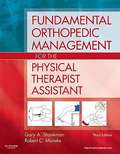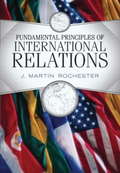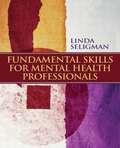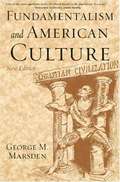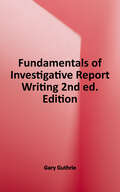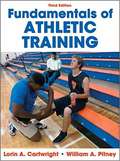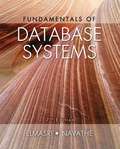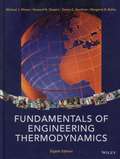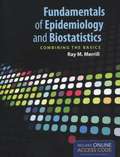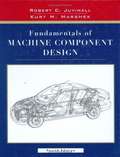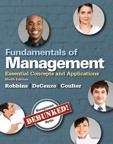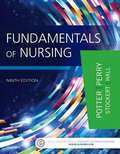- Table View
- List View
Functions Modeling Change: A Preparation for Calculus (2nd Edition)
by Eric Connally Elliot J. Marks Jerry Morris Karen Rhea Pat Shure Carl Swenson Katherine Yoshiwara Deborah Hughes-Hallett Frank Avenoso Philip Cheifetz Ann Davidian Daniel E. Flath Andrew M. Gleason Brigitte Lahme Patti Frazer LockThis is a new edition of the precalculus text developed by the Consortium based at Harvard University and funded by a National Science Foundation Grant. The text is thought-provoking for well-prepared students while still accessible to students with weaker backgrounds. It provides numerical and graphical approaches as well as algebraic approaches to give students another way of mastering the material. This approach encourages students to persist, thereby lowering failure rates. A large number of real-world examples and problems enable students to create mathematical models that will help them understand the world in which they live. The focus is on those topics that are essential to the study of calculus and these topics are treated in depth. Linear, exponential, power, and periodic functions are introduced before polynomial and rational functions to take advantage of their use to model physical phenomena. Building on the Consortium's Rule of Four: Each function is represented symbolically, numerically, graphically, and verbally where appropriate.
Functions and Change: A Modeling Approach to College Algebra (3rd Edition)
by Bruce Crauder Benny Evans Alan NoellThis edition provides an alternative to a traditional college algebra course for students who either will not take another math course or may go on to a business calculus course. An informal approach offers clear explanations that leave out unnecessary technicalities so that students who are not comfortable with algebra will easily understand the concepts.
Functions of Life: Processes Essential to Human Life
by Rivka D. BronnerFunctions of Life: Book One is written for the introductory-level student who wishes to develop a basic knowledge of the functions essential to human life. The text provides a solid foundation in anatomy and a thorough coverage of physiology as it presents an overview of each of the body systems.
Functions, Statistics, and Trigonometry (The University of Chicago School Mathematics Project, 3rd Edition)
by John W. Mcconnell Susan A. Brown Marshall Lassak Paul J. Karafiol Zalman Usiskin Sara Brouwer Mary Ives Rosa Mccullagh Natalie JakucynThe text has been developed by the Secondary Component of the project, and constitutes the core of the sixth year in a seven-year middle and high school mathematics curriculum. All lessons have been reviewed and examined afresh for this edition but the overall content and mathematical prerequisites are the same as in previous editions. New instructional features for this edition include: a Big Idea, Mental Math questions, Activities, Guided Examples, and Quiz Yourself (QY).
Fundamental Accounting Principles
by Barbara Chiappetta John Wild Ken ShawWith 55 years of success in the principles of accounting market, Fundamental Accounting Principles, 21e by Wild, Shaw and Chiappetta has endured and adapted to changes in accounting, technology, and student learning styles. Its innovation is reflected in its extensive use of small business examples, the integration of new technology learning tools, superior end-of-chapter material, and a highly engaging, pedagogical design.
Fundamental Accounting Principles
by John J. Wild Ken W. ShawFor more than six decades, Fundamental Accounting Principles has helped introductory accounting students succeed. With its step-by-step approach, FAP streamlines complex accounting processes and helps students build confidence by mastering key concepts and procedures. Chapter opening vignettes using dynamic entrepreneurs appeal to all students and show the relevance of accounting. Students are encouraged to think like a businessperson and apply what they learn. A wide variety of assignments provide instructors with materials to teach, assess, and challenge students on several levels. Join your colleagues and the millions of students that have used this best-selling learning system to advance their education and careers.
Fundamental Financial Accounting Concepts
by Thomas P. Edmonds Christopher T. Edmonds Mark A. Edmonds Frances M. McNair Philip R. OldsFundamentals of Financial Accounting Concepts delivers a unique approach to building accounting skills while maintaining a more traditional use of debits and credits. Through this method, the authors drive students’ curiosity and inspire them to ask the “why” questions that get at the heart of how Accounting works. By teaching foundational accounting concepts in a logical sequence, the Edmonds author team shifts the focus from memorizing procedures to the development of real-world thinking patterns. <p><p> Author Chris Edmonds has also created a highly popular and widely used series of video lectures, which engage students by clearly and charismatically going over each learning objective in a conversational style. These videos help reinforce important lessons and are always available for review. <p> Through use of the financial statements model and transactional analysis, students quickly see how any given business event affects the financial statements. By having this “big picture” mentality, students can tie any single transaction back to the impact on the overall business. Between the straightforward writing, popular video lectures, and unique coverage approach, Fundamentals of Financial Accounting Concepts enables students to fully comprehend the material presented as future decision-makers.
Fundamental Nursing Skills and Concepts (Ninth Edition)
by Barbara Kuhn TimbyNow in its Ninth Edition, this text combines theoretical nursing concepts, step-by-step skills and procedures, and clinical applications to form the foundation of the LPN/LVN course of study. This edition features end-of-unit exercises, and extensively updated chapters on nursing foundations, laws and ethics, recording and reporting, nutrition, fluid and chemical balance, safety, asepsis, infection control, and medication administration. Coverage includes new information on cost-related issues, emerging healthcare settings, concept mapping, malpractice, documentation and reporting, HIPAA, and more. All Gerontologic Considerations sections have been thoroughly updated by renowned experts.
Fundamental Orthopedic Management for the Physical Therapist Assistant (Third Edition)
by Gary A. Shankman Robert C. ManskeDesigned to meet the unique needs of physical therapist assistants, Fundamental Orthopedic Management for the Physical Therapist Assistant, 3rd Edition focuses on critical thinking and helps you apply fundamental orthopedic principles in physical therapy interventions. Clear explanations cover basic concepts such as the PTA's role in physical assessment of flexibility, strength, endurance, and balance, along with the specifics of tissue healing; medications; gait and joint mobilization; and an introduction to biomechanics. It also describes the application of therapeutic interventions for many orthopedic conditions by region and affliction. Edited by two experienced clinicians, Gary A. Shankman and Robert C. Manske, and written by contributors who are experts in their respective fields, this is your one-stop source for PTA practice in orthopedics. Clear explanations of difficult concepts are provided by experienced, practicing clinicians who address the specific needs of the PTA. Comprehensive coverage provides a "one-stop" source for all things orthopedic, from core concepts related to orthopedics to information about the PTA's role in physical assessment and interventions, in-depth reviews of types of tissue healing, biomechanics, and pharmacology. A focus on critical thinking and application helps to prepare you for the treatment room and for the clinical practicum portions of the curriculum. Key terms and learning objectives begin each chapter, useful as "checkpoints" to which you can refer to ensure content comprehension and study effectively for examinations. Over 500 illustrations reinforce concepts and procedures, supplemented by summary tables and boxes. End-of-chapter review questions prepare you for the types of critical thinking you will be required to do in practice. Unique! End-of-chapter glossaries define key terms. Appendices provide a quick reference for information such as laboratory values, common medications, and associated movements. A six-part structure organizes the book's material: Part I: Basic Concepts of Orthopedic Management begins with the essential concepts of teamwork and shared responsibility within the physical therapy team and then covers the basic areas of flexibility, strength, endurance, balance, and coordination. Part II: Review of Tissue Healing introduces the types of tissue, then discusses ligament, bone, cartilage, muscle and tendon healing before looking briefly at neurovascular healing and thromboembolic disease. Part III: Common Medications in Orthopedics focuses on common medications used in orthopedics, their actions, side effects, and possible impact on treatment. Part IV: Mobilization and Biomechanics deals with the basics of human movement including a chapter on gait, and provides information on joint mobilization. Part V: Management of Orthopedic Conditions by Region covers the body from the ankle, foot, and toes up to the shoulder, the elbow, and the wrist and hand, including a chapter on the spine. NEW! Part VI: Management of Orthopedic Conditions by Affliction includes chapters on hot topics such as rheumatic disease; pain and pain-related syndromes; and bracing, orthotics, and prosthetics.
Fundamental Principles of International Relations
by J. Martin RochesterThis book distills the essential elements of world politics, both the enduring characteristics as well as the revolutionary changes that may be altering the very fabric of the centuries-old state system. Author J. Martin Rochester explores all the important topics that one would expect to find in an IR text (war, diplomacy, foreign policy, international law and organization, the international economy, and more) but injects fresh perspectives on how globalization and other contemporary trends are affecting these issues. In addition, the author does so through a highly engaging, lively writing style that will appeal to today's students. Fundamental Principles of International Relations is a tightly woven treatment of international politics past and present, drawing on the latest academic scholarship while avoiding excessive jargon and utilizing pedagogical aids while avoiding clutter. Rochester ultimately challenges the reader to think critically about the future of a post-Cold War and post-9/11 world that is arguably more complex, if not more dangerous, than some previous eras, with the potential for promise as well as peril.
Fundamental Skills for Mental Health Professionals
by Linda SeligmanThis book is intended to help students and novice clinicians, as well as more experienced clinicians, in the mental health professions of counseling, psychology, and social work to develop competence in the fundamental skills of their profession. With a solid grounding in such skills as effective use of questions, reflection of feelings, eliciting and modifying dysfunctional thoughts, and behavioral change strategies, clinicians can both acquire a sound understanding of their clients and develop strong helping skills.
Fundamentalism and American Culture (2nd edition)
by George M. MarsdenMany Americans today are taking note of the strong political force that is the religious right. Controversial decisions by the government are met with hundreds of lobbyists, millions of dollars of advertising spending, and a grassroots response.
Fundamentals 0f Investigative Report Writing
by Gary GuthrieThis book teaches readers how to precisely construct investigative reports, whether for criminal, employment-policy, or employee-performance investigations. <p><p>Dedicated to helping report-writers produce valuable extrinsic documentation, the book explains how to describe "what happened and why" in clear, concise terms. Topics include writing attitude and ethics, the "always" rules of writing, tips for conducting successful interviews, techniques for writing with precision, purposes and techniques for editing and proof-reading, and how to incorporate sketches, drawings, diagrams, and other visuals. The book also addresses considerations when writing United States Constitutional- based reports, as well as strategies involved in other forms of written communication such as e-mail, business letters, memoranda, and social media. <p><p>This edition features a chapter devoted to performance evaluations that helps supervisors to be accurate, state things efficiently, insure the quality of the organization, and develop the employee. Each chapter includes learning objectives, chapter summaries, specific writing assignments, and a feature story related to the chapter's content-focus. Illustrations have been carefully selected to support the written text. <p><p>Thoughtfully developed to set students and instructors up for success, Fundamentals of Investigative Report Writing is ideal for technical education programs in administration of justice, criminal justice, and law enforcement and courses on investigative and police report writing and report writing for criminal justice and law enforcement professionals.
Fundamentals Of Athletic Training
by Lorin Cartwright William PitneyFundamentals of Athletic Training, Third Edition, explains foundational concepts in athletic training and presents injuries and illnesses commonly encountered by certified athletic trainers. Written specifically for high school students, this text develops the knowledge and skills of students assisting athletic trainers on the field and in the training room as well as those considering future careers as sports medicine professionals.
Fundamentals Of Corporate Finance
by Bradford D. Jordan Randolph W. Westerfield Stephen A. RossThe best-selling Fundamentals of Corporate Finance (FCF) has three basic themes that are the central focus of the book: 1) An emphasis on intuition--the authors separate and explain the principles at work on a common sense, intuitive level before launching into any specifics. 2) A unified valuation approach--net present value (NPV) is treated as the basic concept underlying corporate finance. 3) A managerial focus--the authors emphasize the role of the financial manager as decision maker, and they stress the need for managerial input and judgment. The Eleventh Edition continues the tradition of excellence that has earned Fundamentals of Corporate Finance its status as market leader. Ross' Fundamentals' intuitive approach, managerial focus, and strong end-of-chapter content combine with a complete digital solution to help your students achieve higher outcomes in the course.
Fundamentals Of Corporate Finance (Eight Edition)
by Richard Brealey Alan Marcus Stewart MyersFundamentals of Corporate Finance, by Brealey, Myers and Marcus, provides students with a solid framework of theory and application to use well after they complete the course. This author team is known for their outstanding research, teaching efforts, and world-renowned finance textbooks, so it's no surprise that they provide clear exposition of difficult material without sacrificing up-to-date, technically correct treatments. And with the Eighth Edition, McGraw-Hill's adaptive learning component, LearnSmart, provides assignable modules that help students master chapter core concepts and come to class more prepared. In addition, resources within Connect help students solve financial problems and apply what they've learned. Brealey's personable writing style and world-leading content combine with a complete digital solution to help students achieve higher outcomes in the course. Connect is the only integrated learning system that empowers students by continuously adapting to deliver precisely what they need, when they need it, and how they need it, so that your class time is more engaging and effective.
Fundamentals Of Database Systems
by Ramez Elmasri Shamkant B. NavatheFor database systems courses in Computer Science This book introduces the fundamental concepts necessary for designing, using, and implementing database systems and database applications. Our presentation stresses the fundamentals of database modeling and design, the languages and models provided by the database management systems, and database system implementation techniques. The book is meant to be used as a textbook for a one- or two-semester course in database systems at the junior, senior, or graduate level, and as a reference book. The goal is to provide an in-depth and up-to-date presentation of the most important aspects of database systems and applications, and related technologies. It is assumed that readers are familiar with elementary programming and data-structuring concepts and that they have had some exposure to the basics of computer organization.
Fundamentals Of Engineering Thermodynamics
by Michael J. Moran Howard N. Shapiro Daisie D. Boettner Margaret B. BaileyFundamentals of Engineering Thermodynamics by Moran, Shapiro, Boettner and Bailey continues its tradition of setting the standard for teaching students how to be effective problem solvers. Now in its eighth edition, this market-leading text emphasizes the authors’ collective teaching expertise as well as the signature methodologies that have taught entire generations of engineers worldwide. <p><p> Integrated throughout the text are real-world applications that emphasize the relevance of thermodynamics principles to some of the most critical problems and issues of today, including a wealth of coverage of topics related to energy and the environment, biomedical/bioengineering, and emerging technologies.
Fundamentals Of Epidemiology And Biostatistics: Combining the Basics
by Ray M. MerrillThis book will familiarize students with basic principles of epidemiology and biostatistics. Designed for use in a single course, it will clarify the distinction and complementary roles of epidemiology and biostatistics in a range of settings, and train students on the complementary roles epidemiology and biostatistics play in carrying out selected activities in the health professions.
Fundamentals Of Law For Health Informatics And Information Management (Third Edition)
by Melanie S. BrodnikFundamentals Of Law For Health Informatics And Information Management
Fundamentals Of Machine Component Design
by Robert C. Juvinall Kurt M. MarshekThis indispensable reference goes beyond explaining the basics of mechanics, strength of materials, and materials properties by showing readers how to apply these fundamentals to specific machine components. They'll learn how to solve mechanical component design problems while reviewing numerous examples and working on end-of-chapter problems. With the help of graphical procedures, they'll also gain the skills needed to visualize the solution format, develop added insight about the significance of the results, and determine how the design can be improved.
Fundamentals Of Management: Essential Concepts And Applications
by Stephen Robbins David A. De Cenzo Mary CoulterFor Principles of Management courses. The practical tools of management presented through in-depth practice Fundamentals of Managemen t is a brief, paperback text that gives students more depth and breadth with practical tools to practice their management skills than any other textbook. The Ninth Edition introduces a new and exciting design and includes new chapter openers, case applications, and exercises.
Fundamentals Of Microbiology
by Jeffrey PommervilleHighly suitable for non-science majors, the fully revised and updated third edition of this bestselling text contains new pedagogical elements and an established learning design format that improves comprehension and retention and makes learning more enjoyable. Unlike other texts in the field, Fundamentals of Microbiology: Body Systems Edition takes a global perspective on microbiology and infectious disease, and supports students in self-evaluation and concept absorption. Furthermore, it includes real-life examples to help students understand the significance of a concept and its application in today's world, whether to their local community or beyond. New information pertinent to nursing and health sciences has been added, while many figures and tables have been updated, revised, and/or reorganized for clarity. Important Notice: The digital edition of this book is missing some of the images or content found in the physical edition.
Fundamentals Of Nursing (Ninth Edition)
by Amy Hall Patricia A. Potter Anne Griffin Perry Patricia StockertFundamentals of Nursing, 9th Edition prepares you to succeed as a nurse by providing a solid foundation in critical thinking, evidence-based practice, nursing theory, and safe clinical care in all settings. With illustrated, step-by-step guidelines, this book makes it easy to learn important skills and procedures. Care plans are presented within a nursing process framework, and case studies show how to apply concepts to nursing practice. From an expert author team led by Patricia Potter and Anne Griffin Perry, this bestselling nursing textbook helps you develop the understanding and clinical reasoning you need to provide excellent patient care.
